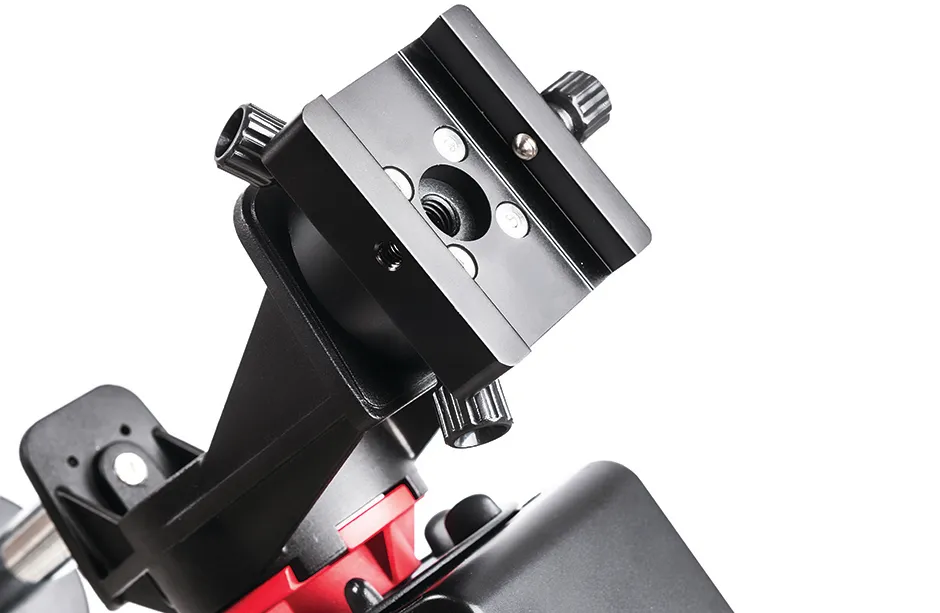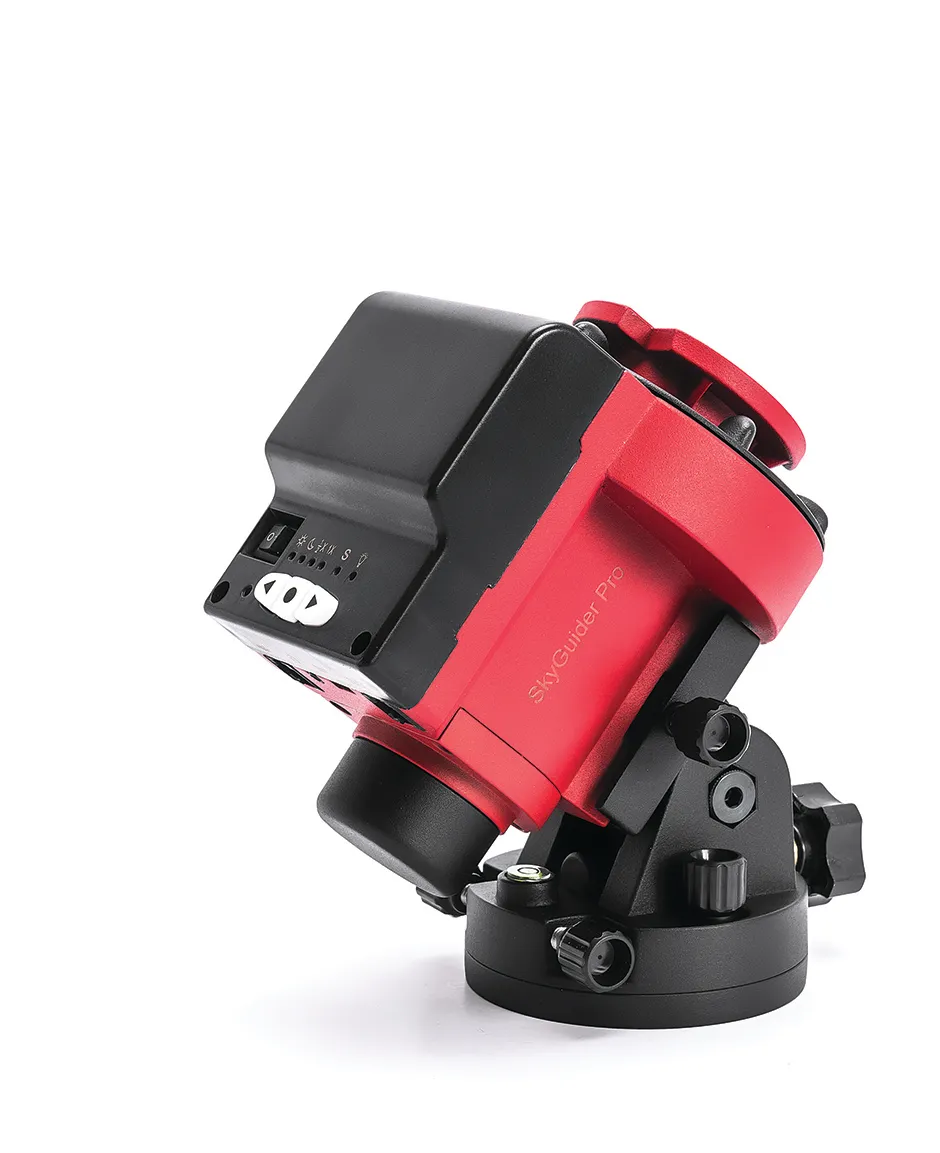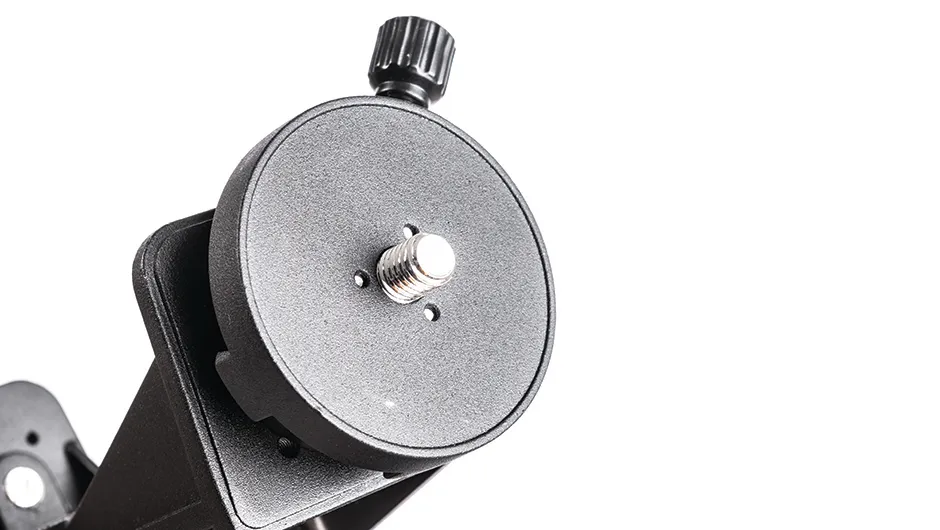Camera tracking mounts have exploded in popularity over the past few years, a trend iOptron has been at the forefront of.The SkyGuider Pro is supplied in a soft padded case, along with a dec. camera mounting block, a dec. mounting bracket with camera-mounting disc, an integrated illuminated polarscope, a 1.35kg counterweight and counterweight shaft, and a Vixen-type dovetail saddle.
You’ll also find a micro USB charging cable and a clearly written manual in the box.
Power comes from an internal Li-Poly 3.7V, 2000mAh battery that can be recharged by using the supplied micro USB cable when the mount is connected to a computer, smartphone charger or portable battery pack.
In the course of our review we used the SkyGuider Pro for around 12 hours; iOptron states that a single charge can provide up to 20 hours of use in ideal conditions.

Assembly was quick and straightforward, though you do have several options depending on the sort of imaging you have in mind.
The mount’s adjustable altaz base is detachable – a new feature of this variant of the mount – so you could simply remove the base, attach the mount directly to a standard tripod and use the tripod’s own pan/tilt mechanism for polar alignment adjustment.
In this configuration, the mount can also be used for slow-motion terrestrial panoramic photography.That being said, we did find that making the sorts of adjustments to polar alignment you need for astronomical purposes became much easier by adding the altaz base to the tripod.
To aid with this there is a free smartphone app called iOptron Polar Scope available for iOS and Android.In this configuration, you must polar align first before adding the camera mounting block, as it covers the view through the polarscope.
We tested this second setup by attaching the mount, ball head and our own modified Canon EOS 300D DSLR with a 16mm wide-angle lens, and taking test exposures of the Milky Way in Cygnus and Lyra lasting for five, 10 and 20 minutes.
The light summer sky meant we had to stop the last exposure down to f/11, but the stars were pinpoint and not trailed on close examination.
Swapping to a 70-300mm lens set to 70mm and f/5.6, we took a five-minute exposure of the Cygnus region. Again, there was no star trailing.
If you want to use a heavy lens on your camera, you may need to remove the ball head and mounting block, swapping them for the dec. mounting bracket and counterweight to achieve balance.
In this configuration we took one-minute exposures of the star cluster M11 with the same DSLR and a 100-400mm lens set at 400mm.The image was likewise free of star trails.
The camera mount has a port for attaching a Go2Nova 8408 hand controller, but this was not available at the time of the review.There is also an ST-4 autoguiding port, though you should bear in mind that it can only guide in RA as there is no dec. motor.
However, for our tests we were very pleased with the general tracking without either, as it works so well.
If you were to purchase a second camera mounting disc, you could attach it to the base of the dec. mounting bracket and add another camera – perhaps for meteor shower photography.That way you can cover double the area of sky and track too.
It’s also worth noting that this mount has uses beyond astrophotography: using the dovetail saddle, we attached a solar telescope to catch a glimpse of the Sun and later a 3-inch refractor to show one of our neighbours a wide-field view of Jupiter and its moons.
It is a great piece of kit and highly recommended.

Compact, portable and versatile
We were impressed with how sturdy the camera mount is given its weight: just 1kg without the altaz base and 1.45kg with it attached.On its own, the camera mount fits into the palm of your hand, and along with its accessories fits into a convenient padded case.
You only need to add your camera gear and tripod to create an ideal travelling system that could be taken anywhere in the world.
Offering the ability to capture both wide star fields, and closer views of nebulae and other large deep-sky targets, there are plenty of targets to keep this system busy for hours of imaging at a time.Throw in the excellent tracking for visual use and it also has use for solar eclipse chasing.

Polarscope
The in-built illuminated polarscope is perfect for getting good alignment.Its adjustable illuminated reticule can be used for both northern and southern hemispheres, ideal if you want to take the mount on holiday.
Adaptable heads
The SkyGuider Pro comes with adaptors for simple wide-field imaging (top left), cameras with heavier lenses (bottom left) and even small scopes via the Vixen-style adaptor. You can also add a second mounting disc to the base of the dec. mounting bracket for dual imaging.
Altaz base
The altaz base is sturdily constructed and is easy to adjust with its fine latitude adjustment control, even while aligning to Polaris using the polarscope.There are two azimuth adjustments and a bubble level to help level to unit.
Switches and guide port
The rubber switches include forward/backwards slewing, while the centre button allows you to select the operating mode.These are solar, lunar, sidereal and half-sidereal, as well as northern/southern hemisphere tracking.Below these are the ST-4 and camera control ports, the USB port for recharging the battery and an HBX port for connecting a hand controller.
Bracket and counterweight
The SkyGuider Pro’s counterweight shaft, counterweight and dec. mounting bracket are now removable, instead of being integrated.The mounting bracket allows you to balance a heavy camera with a large lens – or mount a lightweight telescope – and does not obstruct the polarscope view.
Vital stats
- Price£449.00
- Weight1.45kg
- SupplierAltair Astro
- Telephone01263 731505
- Websitewww.altairastro.com
This review originally appeared in the September 2017 issue of BBC Sky at Night Magazine.
